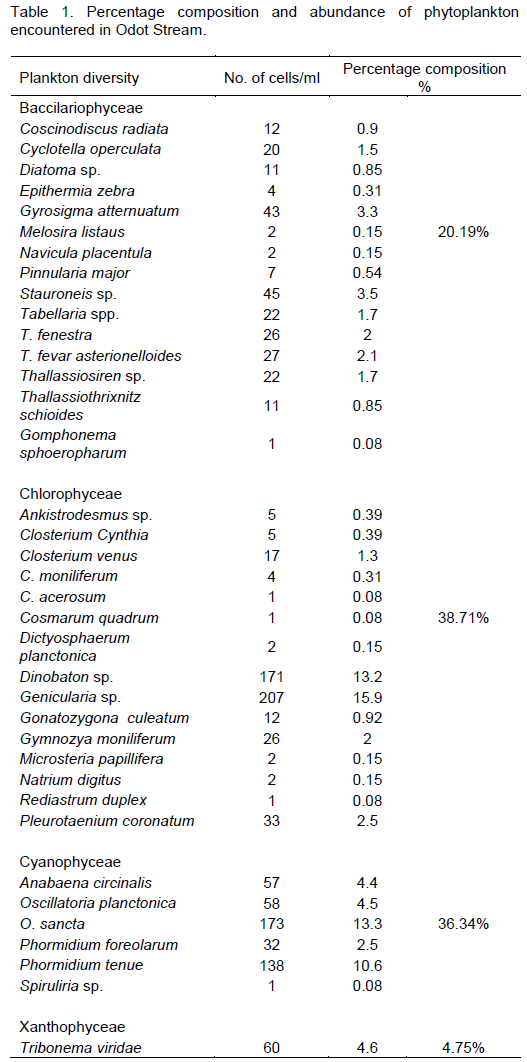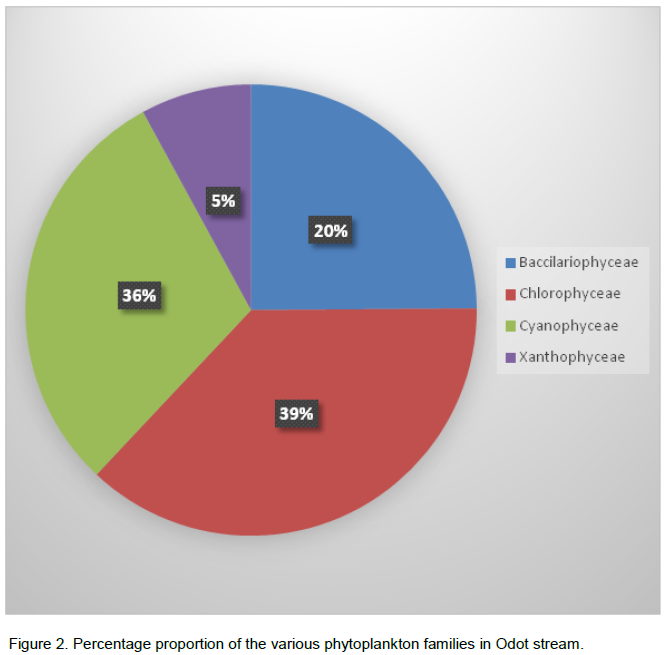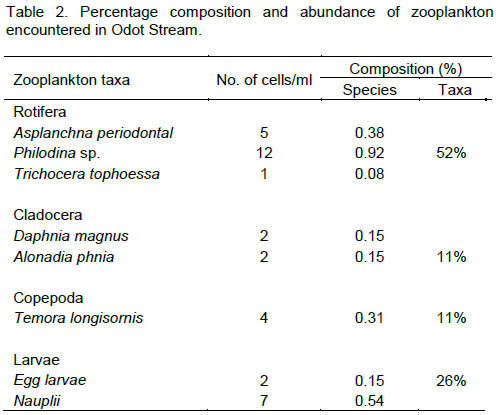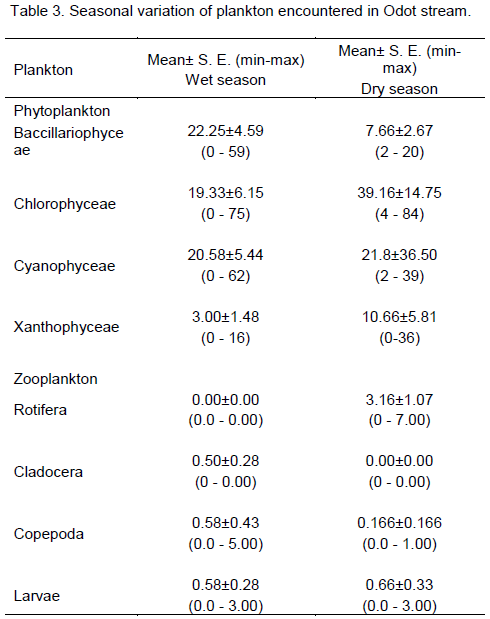ABSTRACT
The plankton of Odot Stream, Niger Delta, Nigeria were investigated between June and August, (wet season) and October - December, 2014 (dry season) using standard analytical procedures. The data generated were subjected to descriptive statistics and community structure analysis. A total of 37 species of Phytoplankton belonging to four taxa were identified in ascending order as follows: Xanthophyceae (4.7%), Baccillariophyceae (20.19%), Cyanophyceae (36.34%) and Chlorophyceae (38.71%). Zooplankton belonging to 4 taxa were also identified in ascending order as follows; Cladocera (11%), Copepoda (11%), Larvae (26%), Rotifera (52%). Higher seasonal abundance among the families were recorded in dry season for Chlorophyceae (39.16±14.75), Cyanophyceae (21.83±6.50) and Xanthophyceae (10.66±5.81) while higher wet seasonal abundance were recorded for Baccillariophyceae (22.25±4.59) and Copepoda (0.58± 0.34). Chlorophyceae and Rotifera were found as the dominant group in this present study and indicated that Odot stream was highly productive (eutrophic), which could be attributed to high temperature due to the shallowness of the stream and its high exposure to sunlight. Excessive algal bloom should, therefore, be checked to prevent the stream from anoxia and poor water quality and shift in species composition and fish kill.
Key words: Odot Stream, phytoplankton, zooplankton, abundance, Bacillariophyceae, Rotifera
Streams and rivers are very important ecosystems for socio-economic development and sustainability of the environment providing a variety of valuable functions to the environment, national economics and the com-munities that depend on them (Mbuligwe and Kaseva, 2005; Yillia, 2008). The presence of an aquatic flora or fauna species in an aquatic habitat readily reflects the characteristics of the environment which they exist, showing that one or more ecological variable is within its tolerance range (Dokulil, 2003). The study of plankton (phytoplankton and zooplankton) is very important because they serve as basis upon which the aquatic ecosystem is supported. The plankton community is a dynamic system that responds quickly to environmental changes; hence they act as indicators of water quality (Wetzel, 2001). Due to several favourable features such as small size, short generation time and a relatively homogenous habitat, plankton organisms are ideal for theoretical and experimental population ecology (Esenowo and Ugwumba, 2010). Several studies have been carried out on various aspects of the aquatic ecosystem in the Niger Delta (Ekpo, 2013; Akpan, 1991; Abowei and George, 2009; Abowei, 2010; Etim et al., 2013; Okiemute and Maduka, 2011). However, no work has been carried out on streams with close proximity to Ibom International Airport one of which is Odot Stream. This study was, therefore, aimed at investigating the plankton composition of Odot Stream as to contribute to the existing knowledge on plankton ecology and distribution and to form S line data for future research.
Description of study area
Odot stream is located in NsitAtai Local Government Area of Akwa Ibom State, Nigeria. The local government has an area of about 17,000 square metres. It is approximately 50 km from Uyo, the capital of Akwa Ibom State. It is bound in the north by Uruan, in the east by Okobo, in the west by Ibesikpo Asutan and in the south by Uyo L.G.A. with coordinates 4°51’O” N and 8°010 ‘O” E (Figure 1).

The bottom of the stream is predominantly sandy and muddy while the edges are without mud. The topography of the catchments is sloppy, making water current to be moderately fast from the upstream to the downstream. Activities in the stream include sand dredging, washing of clothes, bathing, and agricultural activities around the stream banks. The climate of the area is typically of tropical rainforests, comprising the dry season (November -March) and wet season (April - October). The dry season is characterized by a prevalence of dry tropical continental winds from the Sahara desert and the wet season by moist tropical maritime winds from the Atlantic Ocean (Ekpo, 2013).
Selection of sampling sites
Water samples were collected from three sampling stations: IkotNyoho Edo - Station 1 (Upstream), IkotMbre- Station 2 (Midstream) and IkotMboho (Downstream) all in Odot, NsitAtai L.G.A. The streams were selected on the basis of the fact that despite its social, economic and ecological role, no published work is available on it.
Sample collection, preservation, identification and analysis
Sampling was done monthly from the three established sites from June-August and October-December, 2014. Since physico-chemical and biological features of a lotic ecosystem could vary with time, sampling was done at regular and specific time intervals in the midmorning hours between the hours of 8 am and 12 noon.
Water samples were collected using plankton net with mesh size of 55 mm. The plankton net was horizontally towed for about 3 mins just below the water surface. The samples collected were fixed with approximately 5 ml of 4% formaldehyde solutions in the field immediately after collection and taken to Fisheries Laboratory, University of Uyo for analysis. The preserved samples were allowed to settle first in the sampling bottle, then about two-third of the water sample was decanted into a beaker to concentrate the plankton specimen. 1 ml of the water sample was placed in a Petri-dish and mounted under the microscope for viewing (Egborge, 1973) and appropriate keys (Needham and Needham, 1962; Jeje and Fernando, 1986, 1991; APHA/AWWA/WEF, 2005 and Nwankwo, 2004) were used for identification of the plankton. The total number of species was recorded as number of cells per ml for phyto-plankton; while zooplankton were recorded as number per ml.
Community structure analysis
Three indices were analysed for community structure and include species diversity (Shannon and Weinner, 1949); species equitability or evenness (Pielou 1966) and species richness Margalef (1951).
Analysis of Plankton composition and abundance
A total of thirty seven (37) species of phytoplankton belonging to four taxa were encountered and identified during the study period. The most abundant taxa observed were Chlorophyceae with a percentage compo-sition of 38.79% while the least was Xanthophyceae with percentage composition of 4.75% (Table 1 and Figure 2).


The green algal (Chlorophyceae) were the most important group in terms of diversity with the centric forms recording a high abundance. Genicularia sp. dominated with a percentage abundance of 16.38% in the group level and in total number of plankton organism, while the least contributors in terms of number were Gomphonema sphaeropharum, Closterium acerosum, Cosmarium quadrum, Pediastrum duplex and Spirulina sp., accounting for 0.07% respectively. Tribonema viridae was the only species encountered belonging to Xanthophyceae.
In terms of zooplankton, four taxa were identified (Table 2). Rotifera was the most abundant contributing 52% of the composition followed by larvae which contributed 26%, while Cladocera and Copepoda were the least contributing (11% each) (Figure 3).


Seasonal variation among the plankton
The seasonal variation among the plankton was observed and recorded in Table 3. The Baccillariophyceae shows higher seasonal variation in wet season (22.25±4.59) and a lower mean value in dry season (7.66±2.67). Chlorophyceae was observed to be high in dry season (39.16±14.75) and it reduced in wet season (19.33±6.15).
Cyanophyceae showed higher occurrence in dry season (21.83±6.50) and lower occurrence in wet season (20.58±5.44). The family Xanthophyceae showed extremely low occurrence in wet season (3.00±1.48) and higher mean value in dry season (10.66± 5.81). Amongst the zooplankton, Rotifera showed high seasonal variation in dry season (3.16±1.07) and no occurrence in wet season.
Copepod showed high value in wet season (0.58±0.43) and low value in dry season (0.166±0.16). Cladocera showed seasonal variation with high mean value in wet season (0.50±0.28) and no occurrence in dry season. Larvae were observed to show high value in dry season (0.66±0.33) and low mean value in wet season (0.58±0.28).
Community structure
The community structure of plankton was computed as shown in Table 4. The taxa with the highest occurrence


(12) was observed during the months of November in Station 1, December in Station 1 and July in Station 1 and 2. The lowest occurrence in taxa was observed in August, Station 2 being 4. Individual index showed the highest occurrence in July, Station 1 being 150 followed by 142 which occurred in November, Station 1.The lowest individual index was observed in October, Station 3 (24). Dominance index showed high value in December, Station 3 followed by Simpson which showed highest in October, Station 3 (0.84) and lowest in December and July, Station 3 respec-tively. Shannon- weaver index was observed to be higher in October, Station 3 being 2.03 and lowest in August, Station 2 (1.04).Evenness-e^H/S index was observed with high value in June, Station 3 (0.89) and lowest in June, Station1 (0.40). Equitability index showed higher value in June, Station 3 (0.95) and a lower value in December, Station 3 (0.56).
Phytoplankton composition of Odot Stream
The abundance of Chlorophyceae (green algae) in this present study corresponds with the report of Kemdirim (1990) and Subhashree and Patra, (2013). It shows contrast with those of Essien-Ibok et al. (2010), Onyema (2010) and Esenowo and Ugwumba (2010) which reported Bacillariophyceae as highest. Among the chlorophyceae, Genicularia sp. was the most abundant species contributing 16.38% of the total plankton species. This was evidenced most in dry season. As observed in the phytoplankton community structure, Dominanice-D index showed high value in December (0.49). Simpson index revealed highest value in December, station 1 and lowest in July, and Station 3. Individual occurrence ranged from 4-12.
Shannon-H index ranged from 1.04 (August Station1) to 2.03 (October, Station 3). Evenness ranged from 0.37 (July, Station 3) to 0.89 (June, Station 3). The abundance of Chlorophyceae is attributed to high water temperature which would cause high photosynthesis and bloom.
Zooplankton
The abundant group among the zooplankton was rotifer. This corresponds with the findings of Ekpo (2013), and Arimoro et al. (2007). The abundance of rotifer in the stream would be attributed to their ability to undergo vertical migration, which minimizes competition through niche exploitation and food utilization. Also, rotifer richness in the stream probably could be attributed to their pathenogenetic reproductive pattern and short development rates under favorable conditions in most fresh water system (Akin-Oriola, 2003). The author further reported that the rotifers have the shortest life cycle with peak reproductive period of 12 days at 20°C and 5 days at 25°C are normally considered as good indicators of good water quality. Vladimir (1983) suggested that high occurrence of rotifers in any water body indicates an aerobic condition. The result of this study suggests that the rotifer philodinids were more tolerant to environmental stress and that makes it the most occurring organism. This also corresponds with the documentation of Ogbeibu (1998) and Ovie (1997).
Plankton has been used as an indicator to observe and understand changes in the ecosystem. The high relative abundance of chlorophyceae and rotifers indicate that Odot stream is highly productive (eutrophic), which could be attributed to high temperature due to the shallowness of the stream and its high exposure to sunlight. Excessive algal bloom should, therefore, be checked to prevent the stream from anoxia and poor water quality and shift in species composition and fish kill.
A holistic approach to the management of this stream would be to integrate fish production into its water quality management programme as this would enable the evaluation of the present and future conditions of the stream and its ability to sustain present and future needs.
The authors did not declare any conflict of interest.
REFERENCES
|
Akin-Oriola GA (2003). Zooplankton associations and environmental factors in Ogunpa and Ona River, Nigeria. Revised Biol. Trop. 51(2):391-398.
|
|
|
|
Akpan ER (1991). Seasonal variation in Phytoplankton biomass and pigments in relation to water quality in the Cross River System.Ph.D Thesis, University of Calabar. p. 179.
|
|
|
|
|
APHA, AWWA, WEF (2005). Standard Methods for the examination of water and Wastewater. 21st Edn, American Public Health Association, American Water Works Association and Water Environmental Federation, Washinton, DC, United States.
|
|
|
|
|
Arimoro FO, Ikomi RB, Efemuna E (2007). Macroinvertibrate community patterns and diversity in relation to water quality status of river Ase. Niger Delta, Nigeria. J. Fish Aquat. Sci. 2:337-344.
Crossref
|
|
|
|
|
Dokulil MT (2003).Algae as Ecological biomonitors, Elsener Science Ltd. pp. 285-290.
|
|
|
|
|
Egborge ABM (1973). A Preliminary checklist of the phytoplankton of River Oshun. Freshw. Biol. 1(3):569-572.
Crossref
|
|
|
|
|
Ekpo IE (2013). Effect of physico-chemical parameters on zooplankton species and density of a tropical rainforest River in Nigeria Delta, Nigeria using canonical cluster Analysis. Int. J. Engineer. Sci. 2(4):13-21.
|
|
|
|
|
Esenowo IK, Ugwunba AAA (2010). Composition and abundance of Macrobenthes in Majidun River Ikorodu Lagos State. Nigeria. Res. J. Biol. Sci. 5(8): 556-560.
Crossref
|
|
|
|
|
Essien -Ibok MA, Akpan AW, Udo MT, Chude LA, Umoh IA, Asuquo IE (2010). Seasonality in the Physical and Chemical Characteristics of Mbo River, AkwaIbom State, Nigeria. Nig. J. Agric. Food Environ. 6(1-2):60-72.
|
|
|
|
|
Etim EE, Odoh R, Itodo AU, Umoh SD, Lawal U (2013). Water Quality Index for the Assessment of Water Quality from Different Sources in the Niger Delta Region of Nigeria. Front. Sci. 3(3):89-95.
|
|
|
|
|
Jeje CY, Fernando CH (1986). A Practical Guide to the Identification of Nigerian Zooplankton (Cladocera, Copepoda and Rotipfera).Published by KLRI, New Bussa. p. 142.
|
|
|
|
|
Jeje CY, Fernando CH (1991). An illustrated guide to identification of Nigerian freshwater rotifers. Niger. J. Sci. 25:77-95.
|
|
|
|
|
Kemdirim EC (1990). Periodicity and succession of phytoplankton in an upland and lowland impoundments in plateau state(Nigeria)in relative nutrient levels and physical characteristics. J. Aquat. Sci. 5:43-53.
|
|
|
|
|
Mbuligwe SE, kaseva ME (2005). Pollution and self-cleansing of an urban river in a developing country. A case study of Dar Es Salaam, Tanzania Environmental Management, 36(2): 328-342.
Crossref
|
|
|
|
|
Needham JG, Needham PR (1962). A Guide to the Study of Freshwater Biology. 2nd Edn, Holden-Day INC., San Franciso, C. A. p 108.
|
|
|
|
|
Ogbeibu AE(1998). Rotifers of a temporary pond in Okonu forest reserve. Niger J. Sci. Environ.1: 117-134.
|
|
|
|
|
Okiemute IE, Maduka K (2011). The impact of industrial effluent discharge on physico- chemical and microbial parameters of Orogodo River, Agbor, Nigeria. Afr. J. Microbiol. Res. 5(22): 3747-3752.
|
|
|
|
|
Onyema IC (2010).Phytoplankton diversity and succession in the Iyagbe lagoon, Lagos. Eur. J. Sci. Res. 43(1):61-74.
|
|
|
|
|
Ovie SI (1997).Branchionus species of some inland waters in Nigeria with a note on a new record and zoogeography. Tropical Freshwater Biol. 6:27-39.
|
|
|
|
|
Shannon CE, Weinner W (1949).The mathematical theory of communication. Urban University, Illinois press, Illinois. p. 125.
|
|
|
|
|
Subhashree P, Patra AK (2013). Studies on seasonal variations in phytoplankton diversity of River Mahanadi, cuttack city, Odioha, India. Indian J. Sci. Resour. 4(2):211-217.
|
|
|
|
|
Vladimir SC (1983).Rotifers as indicators of water quality. Hydrobiologia. 100(1).169-201.
|
|
|
|
|
Wetzel RG (2001). Limnology: Lake and River ecosystems, 3rd edition. Academic Press, New York 1006 p.
|
|
|
|
|
Yillia PT (2008). Linking land use to stream pollution, pollutant dynamics and management implications. PhD Dissertation.Vienna University of Technology, Australia.
|
|